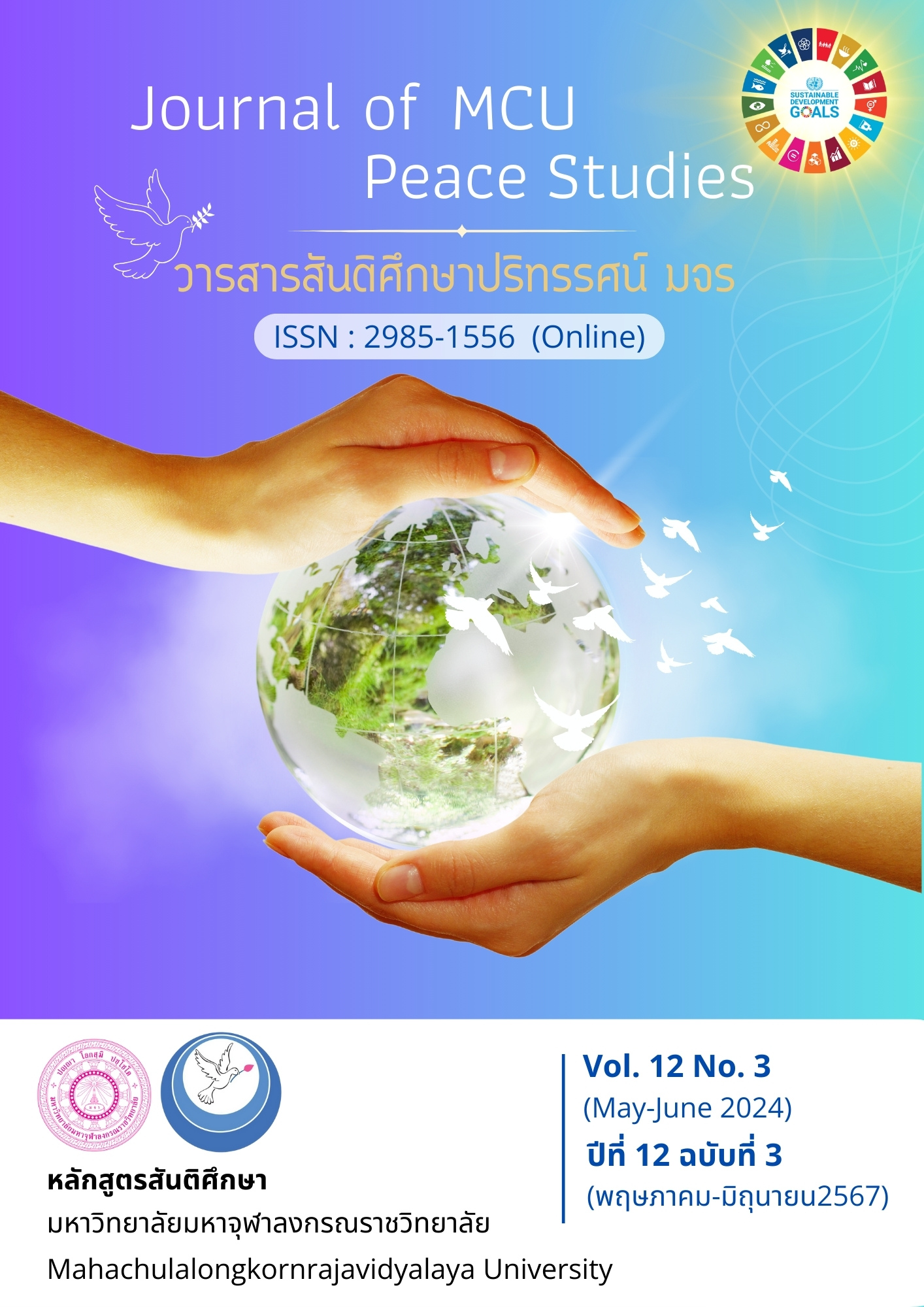การพัฒนารูปแบบการจัดการเรียนรู้เพื่อส่งเสริมทักษะภาษาอังกฤษ ของนักเรียนชั้นประถมศึกษาตอนต้น
Main Article Content
บทคัดย่อ
การวิจัยนี้มีวัตถุประสงค์เพื่อ 1) ร่างรูปแบบการเรียนจัดการเรียนรู้เพื่อส่งเสริมทักษะภาษาอังกฤษของนักเรียนชั้นประถมศึกษาตอนต้น 2) พัฒนาคุณภาพของรูปแบบการจัดการเรียนรู้เพื่อส่งเสริมทักษะภาษาอังกฤษของนักเรียนชั้นประถมศึกษาตอนต้น บทความวิจัยนี้กลุ่มเป้าหมาย คือ ผู้สอน จำนวน 5 คน คัดเลือกจากผู้มีคุณสมบัติคือเป็นผู้สอนวิชาภาษาอังกฤษในระดับประถมศึกษา มีวุฒิการศึกษาระดับ ปริญญาตรีหรือปริญญาตรีขึ้นไปและมีประสบการณ์สอนอย่างน้อย 5 ปี วิธีการคัดเลือกแบบเจาะจง และเป็นนักเรียนที่กำลังเรียนในวิชาภาษาอังกฤษเพื่อการสื่อสาร ภาคเรียนที่1 จำนวน 25 คน วิธีการคัดเลือกแบบเจาะจง เครื่องมือที่ใช้คือ 1) แบบสัมภาษณ์กึ่งมีโครงสร้างสำหรับผู้สอนเป็นการสัมภาษณ์เชิงลึก 2) แบบสังเกตพฤติกรรมการจัดการเรียนรู้ของผู้สอน 3) แบบสังเกตพฤติกรรมการเรียนรู้ของผู้เรียน และ 4) แบบสัมภาษณ์ผู้เรียนเกี่ยวกับปัญหาในการเรียนรู้ทักษะภาษาอังกฤษเพื่อการสื่อสาร สถิติที่ใช้ในการวิเคราะห์ข้อมูล ได้แก่ค่าร้อยละ ค่าเฉลี่ย และค่าเบี่ยงเบนมาตรฐาน
ผลการวิจัยพบว่า 1) รูปแบบการเรียนจัดการเรียนรู้ที่พัฒนาขึ้น ได้ใช้รูปแบบการออกแบบการเรียนการสอนของ ADDIE MODEL ที่มีกระบวนการพัฒนารูปแบบการสอนที่มี 5 ขั้น ประกอบด้วย 1. การวิเคราะห์ 2. การออกแบบ ขั้นนี้เป็นขั้นตอนกระบวนการสอน ประกอบด้วย ขั้นที่ 1 Motivation กระตุ้น สร้างแรงจูงใจให้นักเรียน ขั้นที่ 2 Know (สอนบทเรียน) ให้นักเรียนฝึกฟัง อ่าน, ขั้นที่ 3 Think นักเรียนจัดกลุ่มทำกิจกรรม จับคู่ทำแบบฝึก ขั้นที่ 4 : Result นักเรียนแสดงผลงาน/ชิ้นงาน นำเสนองาน ขั้นที่ 5 (S): Self-assessment/ Students reflection เน้นการประเมินตนเอง 3. การพัฒนา 4. การนำไปใช้ 5. การประเมินผล 2) ตรวจสอบคุณภาพของรูปแบบการจัดการเรียนรู้เพื่อส่งเสริมทักษะภาษาอังกฤษของนักเรียนชั้นประถมศึกษาตอนต้น โดยการตรวจสอบความตรงภายในจากผู้เชี่ยวชาญจำนวน 8 คน ค่าเฉลี่ยความคิดเห็นของผู้เชี่ยวชาญที่มีต่อรูปแบบการจัดการเรียนรู้ มีค่าเฉลี่ย คือ 3.69 เมื่อเทียบกับเกณฑ์แล้วอยู่ในระดับมีความเหมาะสมมาก และการตรวจสอบความตรงภายนอกพบว่า คะแนนทักษะด้านการฟัง ด้านการพูด ด้านการอ่าน ด้านการเขียน อยู่ในระดับดี ซึ่งพบว่านักเรียนมีการพัฒนาในแต่ละวงจรขึ้นเรื่อยๆ และในวงจรสุดท้าย ซึ่งเป็นวงจรที่ 3 นักเรียนมีคะแนนทั้ง 4 ทักษะ คือ ทักษะด้านการฟัง 7.40 ทักษะด้านการพูด 7.12 ทักษะด้านการอ่าน 7.20 ทักษะด้านการเขียน 7.48 และคะแนนประเมินเมื่อสิ้นสุดวงจร นักเรียนมีคะแนนทั้ง 4 ทักษะอยู่ในระดับดี คือ ทักษะด้านการฟัง 7.44 ทักษะด้านการพูด 7.52 ทักษะด้านการอ่าน 7.36 ทักษะด้านการเขียน 7.68 ด้านการฟังด้านการพูด ด้านการอ่าน ด้านการเขียนอยู่ในระดับดี ซึ่งผ่านเกณฑ์ที่ตั้งไว้คือ ร้อยละ 70
Article Details

อนุญาตภายใต้เงื่อนไข Creative Commons Attribution-NonCommercial-NoDerivatives 4.0 International License.
ทัศนะและความคิดเห็นที่ปรากฏในบทความในวารสาร ถือเป็นความรับผิดชอบของผู้เขียนบทความนั้น และไม่ถือเป็นทัศนะและความรับผิดชอบของกองบรรณาธิการ ยินยอมว่าบทความเป็นลิขสิทธิ์ของวารสาร
เอกสารอ้างอิง
Andrade, H. (2008). Self-Assessment Through Rubrics. Educational Leadership, 65(4), 60-63.
Boud, D. (1991). Implementating Student Self-Assessment. (2nd ed). Sydney: Higher Education Research and Development Society of Australasia.
Bunyathorn, I. (1999). Principles of Teaching. Bangkok: Bansomdejchaopraya Rajabhat Institute.
Chaicharoen, S. (2008). Educational Teachnology: Principle Theories to Pratices. Khon Kaen: Klang Na Na Wittaya Press Ltd.
Erikson, E. H. (1966). Eight Ages of Man. International Journal of Psychiatry, 2(3), 281-300.
______. (1987). Childhood and Society. (2nd ed). New York: Norton.
Funchian, N. (2020). 6 Learning Theories that Influence Teaching and Learning Today. Retrieved May 20, 2021, from https://www.trueplookpanya.com/education/content/78212/-teaartedu-teaart-
Gesell, A. et al. (1964). The Child Five to Ten. New York: Harpers and Brothers Publishers.
Jaitiang, A. (2003). Teaching Principles. (3rd ed). Bangkok: Odeon Store.
Johnson, K. (1982). Communicative Syllabus Design and Methodology. Oxford: Pergamon Press.
Joyce, B., Weil, M., & Calhoun, E. (2015). Models of Teaching. (9th ed.). Boston: Pearson.
Joyce, R., & Weil, J. M. (1986). Model of Teaching. New York: Prentic-Hall.
Kemmis, S., & Mc Taggart, R. (1990). The Action Research Planner. (3rd ed.) Victoria: Brown Prior Anderson Nation library of Australia Cataloging in Publication Data.
Kruse, K. (2008). Introduction to Instructional Design and the ADDIE Model. Retrieved October 10, 2008, from http://www.e-learninggunu.com/articles/art21.html
Ministry of Education. (2008). Basic Education Core Curriculum B.E. 2551. Bangkok: Ministry of Education.
Nuttadit, O. (1997). Creation of Spelling Exercises for 4th Grade Primary School Students. (Master’s Thesis). Srinakharinwirot University. Bangkok.
Piaget, J. (1969). The Mechanisms of Perception. New York: Basic Book.
Pilantaowat, O. (2007). Principles and Philosophy of Rhetoric. Bangkok: Chulalongkorn University Press.
Ross, J. A. (2006). The Reliability, Validity, and Utility of Self-Assessment. Practical Assessment Research & Evaluation, 11(10), 1-13.
Satavetin, L. (1993). Principles of Speech. Bangkok: Bangkok University Press.
Senchoavanich, S. (2006). Techniques for reading English for comprehension. (11th ed.). Bangkok: Thammasat University Press.
Siritawee, J. (1998). Techniques for Organizing Activities for Students to Create Knowledge. (Constructivism). Bangkok: Office of the National Education Commission.
Slavin, R. E. (1995). Cooperative Learning: Theory, Research and Practice. (2nd ed.). Massachusetts: Simon& Schuster.
Smit. (2008). General Knowledge about Presentations. Retrieved May 20, 2021, from http://www.tpa.or.th/writer/readthisbooktopic.php?bookID667=&pageid=1&read=true&count=true.2008
Thongphanit, Ph. (2018). The Development of NPU Model: For Encourages Development of Curriculum and Learning Management Innovation. Silpakorn Educational Research Journal Silpakorn University, 10(1), 61-71.
Tumthong, B. (2013). Theory and Development of Learning Management Models. Bangkok: S.Printing Thai Factory.
Vygotsky, L. S. (1978). International Encyclopedia of the Social & Behavioral Sciences. In James D. Wright (Editor-in-Chief). (2nd ed.). Oxford: Elsevier.
Wongwanit, S. (2014). Classroom Action Research. (17th ed.). Bangkok: Chulalongkorn University Press.


